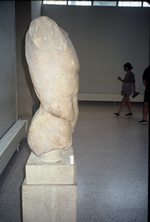History of the Kentro Body Balance Method

This Honduran man moves with comfortable balance. Notice the naturally angled pelvis.
The Kentro Body Balance story begins with the artistic journey of Angelika Thusius, the creator of this method. Already as a teenager, in Honduras, and later - as a professional artist - Ms. Thusius painted scenes of Honduran men and women moving with strength and grace - in harmonious relationship with their everyday activities. In 1972, in Paris, at 30 years of age, Thusius' life changed in an instant. While carrying a heavy box she fell down two flights of marble stairs and injured her back, pelvis and neck. She was in constant pain, uncomfortable in all chairs, and had difficulty sleeping, walking and bending. She was forced to give up her career as an artist. Ten years of physical therapies, acupuncture, exercise and yoga brought minimal relief. She had to continue with costly treatments. A French specialist declared that eventually, she would not be able to walk. Still, she remained hopeful.

A relaxed stance: the pelvis is centered, the spine and legs are vertically aligned and the back is straight.
During many trips to Latin American and Mediterranean countries, she had seen a majority of people (including the elderly) enjoying great freedom of movement. This ignited her passion to live that natural ease in herself and to pass it on to others. At the age of forty, she found some help by taking classes at the Iyengar Yoga Institute in Paris. However, after more years of yoga, balancing stretches and body-oriented therapies, she was still in pain. Shortly after she was certified by the Iyengar Institute, she embarked on a road less travelled. She let go of all prescribed forms and postures as well as limiting beliefs about posture, anatomical function and movement. Thanks to living in many cultures, she observed that people without gyms and exercise programs remain limber and strong through their daily actions. She soon developed the Kentro (Greek for ‘center’) method, which finally resolved all of her pain. Now, at nearly seventy years old, she is also taller, more flexible and stronger than forty years ago.

This Greek athlete is shown bending slightly backward. He is centered,
bending from the small of the back (not from the waist area).
Kentro is the culmination of over thirty-five years of Thusius centering her body as well as researching the motion of young children and adults in twelve countries - including Greece, Honduras, Morocco, England, Italy, Portugal, Spain and Brazil - who remain vigorous and supple throughout their lives. These observations are in accord with the structural descriptions of principal books like "Gray's Anatomy". Thusius expanded her understanding of healthy musculoskeletal function by researching archival and contemporary anatomy books at University medical libraries in London, Athens, Paris and at Stanford University. She also went to the source of Yoga, Chi-gong, and Aikido teachings, which revealed a common denominator with Kentro – emphasis on the main (pelvic) center of the body. This principal area for most strengthening, flexibility and subtle centering is referred to in Sanskrit as ‘asana’, in Chinese as ‘dantien’, and Japanese as ‘hara’. Our pelvis is like the ‘hub’ of a wheel.

This Brazilian man's back is healthy with an even groove (equal space between all vertebrae).
In her first years of developing and teaching the Kentro movements, Thusius emphasized comfortable balance (optimal weight distribution) as the first step to vertical bone alignment and muscle strengthening. Her students experienced release of pain and discomfort. However, most of them continued to harbor judgmental beliefs about their bodies and still aimed at achieving ‘right’ posture. It dawned on Thusius that an affectionate attitude to our bodies is the essential ingredient for abundance of lasting well-being.
The word Kentro reflects this life-enhancing attitude toward our bodies. A friendly attitude combined with simple, subtle, Kentro centering movements refreshes our heart, mind and bodies’ innate healing potential. Seeing our bodies as healthy, graceful and spirited (as opposed to mechanical) is an inherent aspect of Kentro practice.

This elderly Portuguese couple illustrates effortless upright, relaxed sitting.
The movements merge physiology with psyche, anatomy with art, structure with soul. This groundbreaking approach to postural expression awakens our sensing of resilient motion. It allows students to move with personal expression. It restores our sense of pleasurable movement. Joy in our ordinary activities grounds us into expansive connectedness with ourselves, our activities and our environment.
Thusius has been teaching since 1986 throughout Europe and America. Her students include athletes, artists, doctors, dancers, bankers and bakers. She delights in sharing her discoveries with Massage, CranioSacral and Dance therapists, Osteopaths, Chiropractors, Homeopaths, Chi-gong and Yoga instructors.

Centered Ballet Dancer
The pelvis is the main life force area and fulcrum for optimal flexibility and strength. Thusius encourages students to start all activities with a centered pelvis, which prepares the way for centering the torso, limbs and head. Kentro revives our bodies’ original memory of healthy, joyful motion. Engaging in our activities with a relaxed yet toned pelvis helps us embody an attitude of gratitude. By bending forward with centered bodies we move like old-time dancers, athletes, musicians and mimes - when they are giving thanks (see drawing by the author). Thusius’s life work is helping others to move with centered, pleasurable and vitalizing connection with their activities.